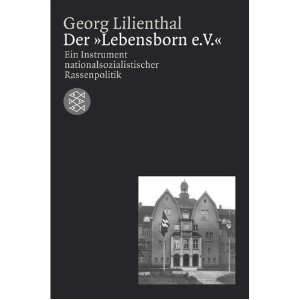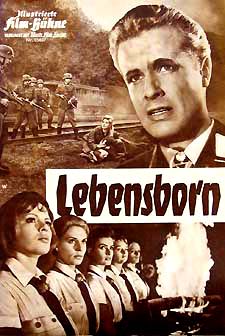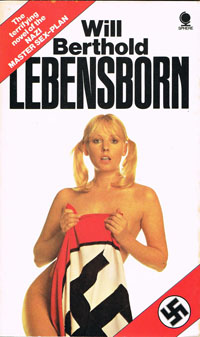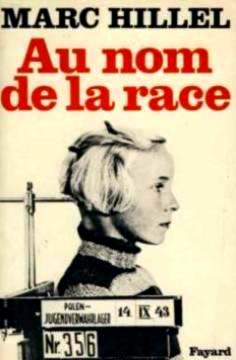
Excerpt from Introduction to "Lebensborn e.V." by Georg Lilienthal (1985)
Translated by C. Porter

[AMAZON BLURB]
Der ' Lebensborn e.V.': Ein Instrument nationalsozialistischer Rassenpolitik [THE LEBENSBORN E.V.: AN INSTRUMENT OF NATIONAL SOCIALIST RACIAL POLICY] by Georg Lilienthal
[Amazon.de blurb]
Even today, the Lebensborn e.V., founded by Heinrich Himmler in 1935, is surrounded by a mesh of legends. The truth is: the homes permitted unmarried mothers to give birth to their children in secrecy, and were then allowed to raise them themselves – in the National Socialist sense. A total of over 8,000 children were born in these homes. The action was later extended to “racially valuable” children from the occupied territories
[book not available in English; amazon book blub translated by C.W. Porter].
Introduction
After the Second World War, the Lebensborn e.V. [registered association] was long considered one of the most mysterious institutions of the National Socialist regime. That its secret could be successfully concealed under the Third Reich attracted a great deal of public curiosity after 1945. The public only learned of its existence during the Nuremberg Trial of Ulrich Greifelt et al, which opened on 20 October 1947 as Case VIII, and ended with the judgement of 10 March 1948 (1).
New legal proceedings before the Hauptspruchkammer [Main De-Nazification Court] of Munich between 14 February and 15 March 1950 revealed no new facts, but were followed by the public with great attentiveness (2). Five years later, the Bundestag also concerned itself with the association, after German Minister for the Interior Schroder was asked for information on the fate of the children formerly entrusted to the Lebensborn homes (3).
In the meantime, the Lebensborn, as a topic, proved so popular, according to a series of articles in the Illustrated Review (4), as to attract the particular attention of the film industry. In 1961, Arthur Brauner [a Warsaw-born Jew who made 13 feature-length films in the same year] produced a film entitled Lebensborn, the kitsch-romantic-erotic content of which specifically and deliberately targeted the public craving for sensation (5).

Authors of imaginative crime fiction in the BDR and DDR, already spoilt by success, now discovered that the mere mention of the word “Lebensborn” produced enough material for highly profitable book sales.
In 1965, the novel Die Schande [The Shame] by Benno Voelkner was published in Rostock by Benno Voelkner, going through four editions. A publishing house in Munich brought out two similar publications in 1975 alone: a “novel based on fact” Lebensborn e.V by Will Berthold

and Die Nächte der langen Messer [The Nights of the
--
Page 8]
Long Knives] by Hans Helmust Kirst. In the same year, German TV stations broadcast a program entitled “...dem Führer ein Kind schenken” [To Give the Furhrer a Child].
Although based on erroneous notions, the programme was characterised by its objectivity. The programme was produced by the French journalists Marc Hillel and Clarissa Henry, who had also attempted to document their research findings by means of the film, accompanied by simultaneous publication of their book Lebensborn e.V. im Namen der Rasse [Lebensborn e.V.: In the Name of the Race].

The Lebenborn’s degree of name recognition temporarily peaked in 1975 (6).
All authors, including screenwriters, based their writings on the unproven assumption that the Lebensborn e.V. acted as a breeding establishment or “stud farm”. Even before 1945, there were many rumours that the association had brought about the planned mating of selected men and women for purposes of racial breeding. Thus, [in 1951], Louis Hagen [British-born son of a wealthy German Jewish banker who was imprisoned in a concentration camp for a while, but not gassed. –C.P.] published the adventure story of a BDM girl who, as a fanatical National Socialist, wanted to have a child engendered in a Lebensborn home “for Volk und Führer” (7). In May 1945, an English journalist interviewed mothers staying in a Lebensborn home who were said to have admitted freely to acting as voluntary “breeding assistants” (8).
These reports, all second or third hand, are of dubious value, since the statements made cannot be verified. Verifiable information relating to certain details proved to be incorrect. Not even in the Nuremberg and Munich trials did the prosecution succeed in proving the existence of “controlled reproduction” in the Lebensborn. To date, not one single former Lebensborn employee, or mother or father, has ever made any claims to this effect.
The widespread belief that the Lebensborn functioned as a breeding institution as a core element of National Socialist racial policy is accompanied by another claim, which is just as old, to the effect that the association was a charitable organisation. Himmler and the Lebensborn leadership justified founding the association on the grounds that unmarried mothers and children needed to be protected from defamation by society.
--
Page 9]
In an odd aberration, the Nuremberg judges adopted Himmler’s view of the matter, and cleared the association on all criminal charges and confirmed its nature as a non-profit organisation. “It is quite clear from the evidence that the Lebensborn association, which existed long before the war, was a welfare institution, and primarily a maternity home [... and] that of the numerous organizations operating in Germany who were connected with foreign children brought into Germany, Lebensborn was the one organization which did everything in its power to provide for the children and protect the legal interests of the children placed in its care” (9). Apologetic literature on the subject is based primarily on this judgement, which attempts to prove the harmless nature of the Lebensborn (10).
In contrast to the great attention which the Lebensborn had now attracted among members of the public, for historical researchers, the Lebensborn remained merely a marginal phenomenon, fleetingly recalled whenever it was felt necessary to illustrate the monstrous nature of Himmler’s racial utopia. For this reason, historical researchers dealt chiefly with the motives which led to forming the Lebenborn association, and the objectives pursued in its activities. The principal characteristics of the Lebensborn association were described as early as 1953 by Himmler biographer Frischauer. The association was said to have been intended by Himmler to contribute to a biological reinforcement of the German people for the purpose of carrying out Hitler’s plan for the conquest of new Lebensraum, not only militarily, but in terms of population policy as well (11).
--
Page 10]
The author was well aware that the Lebensborn contained maternity hospitals and had Germanised children from Poland and Czechoslovakia. A short description of the association was provided in 1962 by Grunberger in 1962 (12). Grunberger provided an indication of the number of homes and the number of children cared for by the Lebensborn as well as the size of the association and the scope of its activities. Grunberger was the first writer to indicate that the association not only received “foreign” children from Eastern and Southern Europe , but “Germanic” children from Northern and Western Europe to Germany.
Ackerman (13) and Thompson (14) succeeded in shedding light on the objectives pursued by Himmler in creating the association: unmarried pregnant women were to be discouraged from having abortions and SS men were to be encouraged to have many children without regard to their marital status. Himmler wished to found a new “morality” based on a racial ideology which made a duty out of producing children. Both authors showed that the Lebensborn was not a marginal phenomenon, to be considered in isolation, but rather in connection with Himmler and the NSDAP’s other racial-political measures, the objective of which was to effect an acceleration in the birth rate and a growth in population, in particular, in favour of the SS.
The Lebensborn was sometimes also considered a social institution. The fact that many unmarried mothers were able to perceive Lebensborn support as relieving their personal situation, and the assumption that the social character of the association was only said to have been restricted to a privileged group of persons as a result of the racial-ideologically motivated selection, led the authors to a beneficial interpretation (15).
Other authors were more inclined to the fantastic interpretation of the Lebensborn as an experimental field for National Socialist breeding attempts. Joachim C. Fest, in his book The Face of the Third Reich, called the association
--
Page 11]
“a governmental bordello organisation” (16). And Karl Dietrich Bracher wrote of “Himmler’s Lebensborn breeding programme which attempted to bring about the Nordic refreshing of the Germanic Master Race [Herrenrasse] by means of selected SS bordellos” (17).
The confusion which now prevailed to an equal extent among both the general public and historical scholars as well, became even worse when the French journalists Hillel and Henry published their book on the Lebensborn in 1975 (18). They were convinced that they had, at long last, proven that impregnations had been organised within the Lebensborn. Their assumption, is, however in error, as it is based on misinterpretations and insufficient analysis of sources. On the other hand, they rendered the service of making the public aware of the original documentation of the Lebensborn and informing the public of the association’s participation in the Germanisation of foreign children in detail for the first time.
Independently of Hillel and Henry, short, accurate studies of the Lebensborn were published in the following years (19). They are an indication that a change had occurred in modern historical research in the sense that the question of the realisation of the National Socialist ideology had acquired increased attention as the core element of interest.
Of course, it was soon noted that Third Reich racial policy, true to the racial dogma, was based on the mutual principle of selection and extermination, whose measures were proven in the literature with the functional concepts of “breeding” and “extermination” (20). No consequences were drawn from this recognition in terms of the writing of history. In view of the millions of victims, caused primarily by the persecution of the Jews, National Socialist racial policy was primarily identified with racial anti-Semitism (21). Breeding measures [Zuchtmassnahme]
--
Page 12]
were only perceived as a marginal phenomenon [so did any such measures exist, or did they not? -C.P.] or were only taken into consideration when they were classified as criminal, such as the so-called “euthanasia” programme.
In examining the question of whether Hitler’s policy followed a “programme”, greater attention should also be paid to the breeding aspect of National Socialist racial policy. As a result, the attempt should be made to give sharper contours to the mysterious phenomenon of the Lebensborn e.V.
At the same time, researchers should attempt to go beyond the mere history of the organisation and the function of the association in the individual phases of the Third Reich as well as its location in National Socialist racial policy (22). The Lebensborn was not an autonomous organisation, detached from all the imperatives of policy and legislation, the tasks of which related solely to racial policy, but rather, it was – in contrast to the impression prevailingly given by the literature – bound by the rules of power politics and initially to the regulations of the state of law.
It will be seen here that, with Himmler’s support, it participated in the play of intrigue of policy and the disassembly of the legal order in order to seek its own advantage. At the same time, the NSV, which defended the interests of the Party, proved itself a stubborn competitor to the SS association.
The Lebensborn was not an institution operating in secrecy like a laboratory conducting experiments in racial breeding. Rather, it was bound up in National Socialist racial policy, reflected in the aggressive birth rate policy after 1939, in the so-called “Germanic policy” and “ethnicity policy”. An effort should be made to depict the manner in which the demand for reproduction-related selection was reflected in concrete measures. In this connection, it is decisive for an understanding of a racial breeding policy, such as was practiced in the Lebensborn e.V., to understand that the maintenance of illegitimate children was regulated by law. With the discovery of racial reproduction functional mechanisms, it becomes clear that the Lebenborn was not a charitable institution and did not require “controlled reproduction” in order to be qualified as an instrument of racial breeding policy.
The present edition is a revised edition of the book of the same name,
--
Page 13]
published in 1985 (23). The present book is intended to contribute to the increasing more objective in-depth study of the topic on the part of the public. For example, an effort has been made to reappraise the history of the individual homes (24). Above all, former Lebensborn children are attracting constantly increasing attention. So far, only a few of them have reported on their traumatic experiences and the consequences for their lives. They were all victims of Germanisation measures. First, children kidnapped out of Poland began to speak out (25). Their publications were however not known outside of the country. A few years ago, however, children born in Norwegian Lebensborn homes have also begun to speak out. In 1986, Turid published her life experience in Norway, which was published two years later in German (26). In 1989, German television viewers were confronted with the tragic story of six additional children from Norway (27).
In the meantime, in 1986, in Norway, the first of these “Norwegian war babies” organised themselves in a common interest group. Following their example, a few children born in Norway and who grew up in Germany have been meeting in a former Lebensborn home in Saxony since 1990, without forming a formal association.
These examples should encourage all children who were ever cared for by the Lebensborn in any manner, or who were kidnapped in foreign countries or born in its German homes, to express their resulting cares and needs as well.
--
1) Documents from Case 8 have been printed in extract form in Trials of the War Criminals before the Nuremberg Military Tribunals, vols IV and V, Washington 1950.
2) See the report of the Frankfurter Allegemeine Zeitung of 15.2, 16.2, 17.2, 24.2, and 16.3.1950.
3) “Kinder aus der SS Retorte. Das Bundesinnenministerieum forscht nach dem Schicksal der Lebenborn-Kinder/Statistik des Grauens“. [Children from the SS Test Tube: The German Ministry of the Interior researches the Fate of the Lebensborn Children/Statistics of Horror“] in: Suddeutsche Zeitung of 21.2.1955.
4) Will Berthold: Lebensborn e.V. 1958.
5) See the discussion entitled “Brides of the Führer” in: Der Spiegel 15 (1961), no. 2 of 4.1., pp. 59-61.
6) In Poland a publication by Roman Hrabar appeared under the title “Lebensborn”. Czyli zrodlo zycia. Katowice 1975. It is a collection of information taken from international historical research, the press and entertainment literature, without sufficient separation between facts and speculation.
7) Louis Hagen, Follow My Leader, London 1951, p. 253-288.
8) Judy Barden: Freundin und Candy. In: Das ist Germany. Published by Arthur Settel, Frankfurt am Main, 1950, pp. 148-161. Himmler’s personal physician, Felix Kersten, provides expressions of his patient, which might at first glance awaken the impression in the reader that the Reichsführer SS had initiated a breeding programme in the Lebensborn. Felix Kersten: Totenkopf und Treue. Heinrich Himmler ohne Uniform. Hamburg 1952, p. 230.
9) Trials of War Criminals, vol. V, p. 162 f. Former Lebensborn employees and the defence attorneys stressed before the Nuremberg Tribunal, that the association had nothing to do with the population and racial policies of the SS. Thus, Dr. Hans-Hilmar Staudte for the defence, declared that the “objectives of the Lebensborn [...] were not of a nature related to political or population policy”. “Rather, the objective was to alleviate the social position of the mother and her child” [...]. The defamation of unmarried mothers was to be eliminated, the stain of the child’s illegitimacy was to removed. These purely social objectives have nothing to do with population policy objectives”, sworn statement of 29.6.1946, Sollman, doc. no. 5, p. 8. Emphases in the original are always given in italics in the quotation. In their final summation, the defence maintained that the “non-profit” Lebensborn association concentrated its efforts on the “then so-called positive struggle against abortion” and on the “care for war orphans and widows” . “Since then and as a result of this activity, originally established concepts such as for example “racial selection” no longer played a decisive role in the Lebensborn”. “The charitable, i.e., altruistic tendency and activity of the Lebensborn was undisputed”. Defence trial brief for Sollman, Ebner, Tesch, et al, p. 2.
10) See Alfred Wenzel: The Lebensborn association in: Die Freiwillige. Kameradenschftsblatt of the HIAG3 (1958), p. 4, 4 (1959), p. 7 ff., p. 17 ff., p. 22-24, 5 (1960), p. 17. A[rthur] E[hrhardt]: Lebensborn – oder Volkstod: In Nation Europa9 (1959), p. 35-42. Anonymous: Immer noch: Lebensborn. In: Der Freiwillige: Kameradenschaft der HIAG6 (1961) p. 23-25. Erich Kern: Meineid gegen Deutschland. Eine Dokumentation über den politischen Betrug. Glttingen 1968, chapter „Weltweiter Schwindel mit dem Lebensborn“, p. 45-72.
11) Willi Frischauer: Himmler. The Evil Genius of the Third Reich. London 1953, pp. 97-99, pp. 138-140 and 196ff.
12) Richard Grunberger: Lebensborn. Himmler’s Selective Breeding Establishment. In: The Wiener Library Bulletin 16 (1962), p. 52ff.
13) Joseph Ackermann: Heinrich Himmler als Ideologue. Göttingen, Zurich, Frankfurt am main, 1970, pp. 126-141.
14) Larry v.Thompson: Lebensborn and the Eugenics Policy of the Reichsführer-SS: In: Central European History 4 (1971), pp. 54-77.
15) “In practice, the association, like similar institutions in democratic countries, offered a home to innumerable illegitimate children and protected unmarried mothers from defamation and suffering.” Sittengeschichte des Zweiten Weltkrieges, Hanau am Main, 1968. (Sittengeschichte des 20.ten Jahrhunderts, begrundet von Magnus Hirschfeld, vol. 3), p. 240. See the commentary to his article on the Lebensborn, in: Facsimile Querschnitt durch das Schwarze Korps. Published by Helmut Heiber and Hildegard v. Kotze. Munich, Bern, Vienna 1968, p. 34, note 124.
16) Joachim C. Fest: Das Geschicht des Dritten Reiches. Profile einer totalitaren Herrschaft (6th edition). Munich, Zurich (1977), p.368.
17) Bracher, K.D., G. Schulze, W. Sauer, Die Nazionalsozialistische Machtergreifung. Studien zur Errichtung des totalitaren Herrschaftssystem in Deutschland 1933-34. Part I: Karl Dietrich Bracher: Stufen der Machtergreifung (reproduction of 2nd edition 1962). Frankfurt am Main, Berlin, Vienna 1974, p. 388.
18) Au nom de la race. Paris 1975. German edition : Lebensborn e.V. Im Namen der Rasse . Vienna, Hamburg 1975.
19) Hans Mausbach and Barbara Mausbach-Bromberger: Feinde des Lebens. NS-Verbrechens an Kindern. Frankfurt am Main, 1979, p. 53-62. Roman Hrabar, Zofia Tokarz, Jacek E. Wilczur: Kinder im Krieg – Krieg gegen Kinder. Die Geschichte der polnischen Kinder 1939-1945. Reinbeck 1981, p. 383ff.
20. Bracher, Machtergreifung, 2nd edition, 1962, p. 285. Zur Bedeutung des Begriffs „Züchtung“, see below, p. 19.
21. Symptomatic of this state of affairs is the bibliography to the section „Nationalsozialistische Rassenpolitik“ in Karl Dietrich Erdmann: Die Zeit der Weltkrieg. 2nd supplement, Stuttgart 1976. (Gebhardt: Handbuch der deutschen Geschichte. 9th erevised edition, vol. 4), p. 419. See also Peter Huttenberger: Bibliographie zum Nationalsozialismus, Göttingen 1980 (Arbeitsbucher zur modernen Geschichte, vol. 8). One section is missing: „Racial policy“. Instead, there are two sections entitled “Jews” and “Life Extinction”.
22) Socio-historical questioning, especially in relation to the unmarried mothers and fathers must fade into the background on the other hand, in addition to which the source material in this regard does not permit one to make reliable statements.
23) Published in 1985 by the Gustav Fischer Verlag, Stuttgart, in the series “Forschungen zur neuen Medizin-und Biologiegeschichte” as vol. 1.
24). Lothar Bembenek: Aussenkommando Lebensbornheim Taunus Wiesbaden. In: Hessen hinter Stacheldraht. Vedrangt und Vergessen: KZs, Lager, Aussenkommandos. Published by den Grünen. Frankfurt am Main, 1984, p .77-82. See also at this point Georg Lilienthal and Michaela Pohl: Das lebensborn Hieim Taunus in Wiesbaden (1939-1945). In: Nassauische Annalen 103 (1992), p. 295-310. Rainer Heubeck: Aus Frankreich und Belgien evakuierte Kinder waren im Lebensborn Heim am Bocksberg untergebracht. In: Frankische Landeszeitung no. 140 of 21.6.1990.
25) Aloizy Twardiecki: Szkola Janczarow, Listy do niemieckiego przyjaciela. Warsaw, 1969.
26) Veslemoy Kjendsli: Kinder der Schande. Berlin 1988.
27) Report by Thomas Euting entitled „Vater, warum schweigts Du?“, in ZDF on 29.8,1989.
--
End of translation by C.W.Porter
---
LINKS
Excerpt from introduction to "Der Lebensborn, e.V,", by Georg Lilienthal (translated by C.W. Porter) click here
Excerpts from pp 150-155 of "Der Lebensborn, e.V,", by Georg Lilienthal (translated by C.W. Porter) click here
Excerpts from “Deutsche Mutter, bist du bereit” ["German Mother, Are You Prepared?"] by Dorothee Schmitz-Köster (translated by C.W. Porter) click here
Excerpt from Chapter 1 of “Dem Führer ein Kind Schenken” by Volker Koop (translated by C.W. Porter) click here
Excerpt from pp. 232-34 of “Dem Führer ein Kind Schenken” by Volker Koop (translated by C.W. Porter) click here
Excerpts from "Master Race: The Lebensborn Experiment in Germany" by Catherine Clay and Michael Leapman -- click here
"Master-Race"/Lebensborn Internet World Lie Championships FIRST PRIZE -- I Am a Lebensborn Child -- click here
"Master-Race"/Lebensborn Internet World Lie Championships SECOND PRIZE -- "Master Race Baby" Olaf Schmedermann -- click here
"Master-Race"/Lebensborn books on amazon.com, amazon.de and amazon.fr (with translations) click here
"Master-Race"/Lebensborn World Championship Lie Videos on youtube.com (with translations) click here
Review of History Channel's "History's Mysteries: The Lebensborn (reviewed by C.W. Porter) click here
Filmography of Arthur Brauner, "German" producer of world's first "terrifying" trash film epic about "Nazi sex farms" (completed in 3 weeks) -- click here
The Non-Existence of any Nazi "Doctrine" of the "Master Race" -- click here
The "Master Race" accusation at Nuremberg -- click here
Jewish Racism - click here
Excepts from "Myth of the Twentieth Century" -- Use of word "Herrenvolk" by Alfred Rosenberg -- click here
Use of word "Master Race" in standard literature -- click here
Anti-Nazi "Master Race" sexploitation pics -- click here
Nazi "Sex Farms" -- The Lie... and the Reality... click here
Explanation of remarks on William L. Shirer -- click here